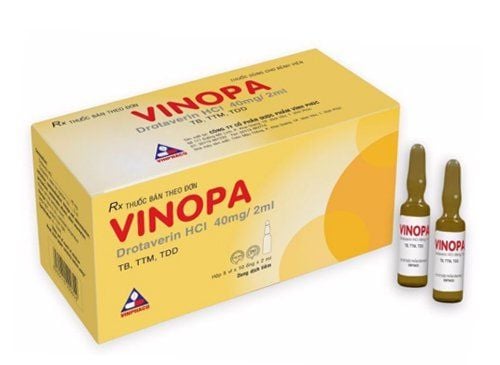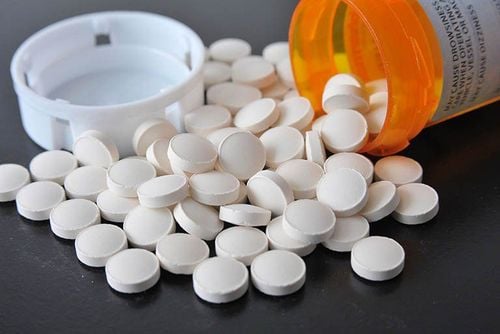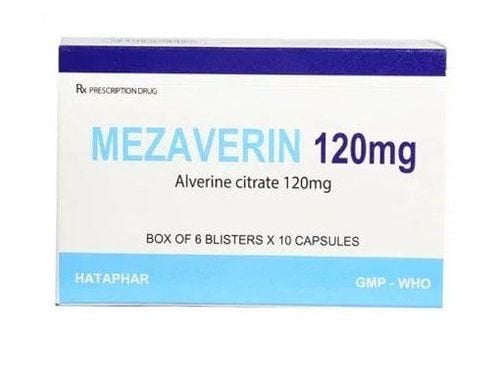This is an automatically translated article.
Quinospastyl has the main ingredient Alverine 40 mg, which is commonly used in the treatment of internal muscle spasms in the gastrointestinal tract, biliary tract, uterus... Find out general information such as ingredients. , indications, contraindications, dosage and notes when using Quinospastyl will contribute to improving the effectiveness of treatment for patients and their loved ones.
1. What is Quinopastyl?
Quinospastyl medicine 40 mg is made in the form of capsules, with the main ingredients including:
Active ingredient: Alverine (as Alverine citrate) 40 mg. Excipients: Just enough for 1 capsule. Alverine citrate is a smooth muscle antispasmodic of the Papaverin class, with a direct effect on smooth muscle fibers. The mechanism of action of Alverine citrate is mainly based on 3 main mechanisms including: Blocking calcium channels, inhibiting Serotonin 5HT1A receptors and reducing intestinal sensitivity. Therefore, this active substance is used as an antispasmodic agent acting directly and mainly on gastrointestinal smooth muscle and uterine smooth muscle. Alverine citrate has the effect of reducing pain caused by intestinal smooth muscle spasms seen in digestive disorders, pain caused by uterine smooth muscle spasms seen in dysmenorrhea, threatened miscarriage...
2. What are the effects of Quinospastyl?
Quinospastyl is indicated in the treatment of smooth muscle sphincter seen in:
Gastrointestinal tract: Irritable bowel syndrome, pain due to biliary spasm in gallstones, cholangitis and diverticulitis of the colon. Urology: Pain in renal colic. Uterus: Dysmenorrhea, dysmenorrhea and threatened miscarriage. However, in the following cases, the drug Quinospastyl is not allowed to prescribe:
Hypersensitivity to any ingredient of the drug Quinospastyl. History of allergy to other medicinal products containing Alverine citrate Intestinal obstruction or paralytic ileus. Intestinal obstruction due to feces. The patient has a loss of colon tone.
3. Dosage and how to use Quinopastyl
Dosage:
Adults or children ≥ 12 years old:
Recommended dose: Take 2 - 3 tablets (80 - 120 mg) / time x 2 - 3 times / day. Children:
Not recommended because safety has not been established.
Side effects encountered when using Quinopastyl
The use of the drug Quinopastyl usually causes few side effects. However, if used in high doses or for a long time, it may cause side effects such as:
Common: Gastrointestinal disturbances such as nausea, vomiting. Nervous disorders such as headache, dizziness, dizziness and hypotension. Uncommon: Allergic reactions such as rash, rash, redness of the skin, urticaria, laryngeal edema, in severe cases, anaphylaxis. The drug should be stopped when detecting the above undesirable side effects or other unusual symptoms, and at the same time, the patient should promptly notify the doctor or immediately go to the nearest medical facility for timely treatment. .
4. Note the use of Quinopastyl in the following subjects:
Avoid using Quinopastyl in children under 12 years of age because studies on its safety are limited. Pregnancy: Clinical studies have not demonstrated teratogenic or other adverse effects on the fetus of Alverine citrate in Quinospastyl. Therefore, caution should be exercised when Quinospastyl is used during pregnancy. Lactation: There is no evidence of safety regarding the use of Alverine citrate in lactating women. Therefore, breastfeeding should be discontinued when deciding to use Quinopastyl. Drivers or machine operators often experience side effects such as headache, dizziness, dizziness ... after taking Quinopastyl. Therefore caution is required.
5. Quinopastyl drug interactions
Quinopastyl reduces the absorption of drugs used orally because it reduces gastric smooth muscle motility.Above is basic information about ingredients, uses, doses and notes when using Quinospastyl. Patients and relatives should carefully read the instructions for use of Quinopastyl and strictly follow the instructions of the treating doctor to get the best treatment effect.













